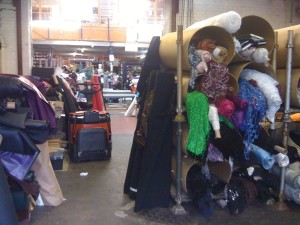Today’s trip to the vast Woolcrest textile warehouse on Hackney’s Well Street leaves us relieved and excited. We are planing to make real wool toiles to get a sense of how the designs work. At £5-£10/m the fabric is only 2-3 times the price of calico. This will enable us to test what we want to achieve with the construction finishes before we start cutting into the beautiful Dashing Tweeds weaves.
Synthetic dyes in the Mauve Decade
Ideologically, the shopping trip brings up many of the continuing questions about how we date the fabric and the kinds of historicity we are exploring. What’s really exciting about the fabrics available now is that they contain dyes that would not have been possible in the victorian era, and so some of the colours are strikingly contemporary, but subtly so at first glance. The vivid synthetic oranges, blues and pinks for example in these wools would have certainly attracted the women, and tailors of the 1890s for their innovation. I choose an indigo blue and burgundy/ mauve coloured wool for Kat and then a few with pastel colours and oranges which reflect Dashing Tweeds’ bright palette. This palette is becoming more interesting to me, and something which the black and white photos and illustrations which typify our go-to references can’t convey.
Digital printing
In addition to the wools, I am interested in the ways cottons and linens, and digitally printed fabrics, have evolved to mimic the effect of the wools. This will inform the screen printing we hope to do later on in the project. While printing technology isn’t news to today’s fabricators, being immersed in the literary worlds of the characters is beginning to inform these stories and designs. I am now seeing the materials and processes through the eyes of the women of 1890s and trying to imagine what I might have wanted as a radical fashion maker and consumer of the time.
Shopping local
The choice is much bigger than the 1900s thanks to cheap shipping logistics and an international commercial trade infrastructure reliant now on streamlined mass manufacturers in China or Bangladesh, where these wools (or their constructed parts or components) are likely to have come from. While we’ve spent a good deal of time considering technological innovation, this vast availability brings up whole new dilemmas about the provenance of materials available to us. Contemporary consumers are accustomed to the ethics of choosing local and the stories of the horrific life sacrifices made by workers in External Processing Zones where outsourcing of western fashion brands demands the raw material prices that allow us to find something these prices.
While international trade routes were firmly established in Victorian England’s technological revolution, locally sourced manufacture wouldn’t have been about ethical choices, but about availability, choice, and community (The Rational Dress Gazette’s recommended Mr Marcus of Bedford Square and The Lady Cyclist promoted local tailors such as Alfred Day, London, or Mr Cook, Dudley). While this low price allows us to experiment with and understand the affordances of materials, our community based relationship to our supplier of choice, Dashing Tweed remains the best way to carry the project’s physical outcomes to fruition. It’s likely that once we make trial pieces these fabrics will enable us to choose how we work with Dashing Tweed’s materials, and may allow us to mix in pieces we make in a collage of contemporary dilemmas and processes as they come up.
Eg of the choices- polycotton, linen and wool at £2, £5 and £7/m






This Post Has 0 Comments